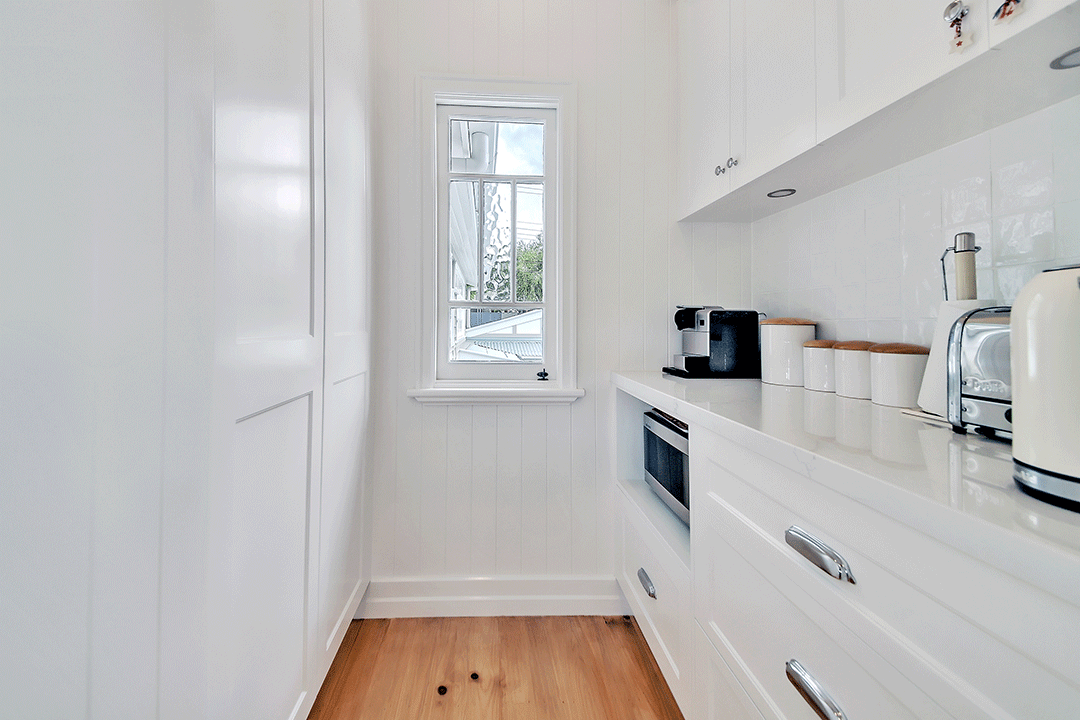Behind The Scenes
Whether you’re entertaining guests or keeping meal preparation concealed, incorporating a butler’s pantry into your kitchen puts a contemporary twist on the concept of additional space. This feature has increased in popularity over the years, due in large part to the kitchen’s reputation as the central hub of the modern home, and an enduring love of hosting dinner parties and cooking for others. Olivia Morffew speaks with Robert Mayer, managing director of Maytain Cabinets, to learn about the ins and outs of these hidden wonders.

There are many elements to consider when it comes to designing and installing a butler’s pantry. This ancillary zone should be a natural extension of your primary kitchen, boasting additional kitchenware storage and extra space for meal preparation. There’s no one-size-fits-all policy when it comes to a butler’s pantry, as each kitchen and homeowner has different needs and requirements. Read ahead to learn about the various aspects that are crucial for creating the perfect butler’s pantry for your home and lifestyle.
SECRET STYLISH STORAGE
One of the reasons homeowners choose to add a butler’s pantry to their kitchen is the prospect of additional storage for their kitchenware and appliances. While extra room for your cooking goods is a brilliant concept, homeowners should be wary of hidden pitfalls prior to design.
Installing deep shelves can be an issue, as hard-to-reach items can get lost in such a confined space. While most homeowners would assume cupboards are the go-to for optimum storage in place of shelving, opening and closing these doors can become a hindrance in these tight nooks. This is where open shelving and drawers offer the ideal solution for storing bulk goods and other kitchen utensils that you don’t want to display in the main cooking and entertaining areas. “Shelving should be shallow: 450mm maximum is best,” Mayer advises. This size and depth will guarantee easy access to kitchenware and other household items. Installing drawers at either bench height or lower achieves a similar result. This gives you room to move in and out of the butler’s pantry with ease, making catering and entertaining easier and obstacle-free.
TO HIDE OR NOT TO HIDE
One of the main purposes of a butler’s pantry is to conceal items you don’t want to be seen; unwashed plates, meal preparation, bulk-bought groceries, and small appliances that aren’t in use. To add a mysterious element to your butler’s pantry, doors can be installed to hide this secret spot. A cavity sliding door is the perfect choice here, as it doesn’t impact the space in and around the butler’s pantry. If you go down this route, you can craft an entry door from materials, colours and textures that are used throughout the main kitchen to hide the butler’s pantry in plain sight.
For those that prefer an adjoining pantry that connects seamlessly with the kitchen, the open-plan, door-less butler’s pantry is the option for you. “The pantry will get a lot of use so easy access is a good option,” Mayer says. “We have seen a lot of open-plan sculleries recently with no door.” Taking this approach to your butler’s pantry creation will ensure stylistic cohesion between the kitchen and this secluded space. Omitting a door allows for “a continuity of materials and surfaces to flow from the kitchen”, creating a pantry that’s aesthetically pleasing and harmonious with the cooking and entertaining areas.
As long as the butler’s pantry is adjacent to the main kitchen and close enough for a smooth transition from one room to the next, hiding your butler’s pantry or having a walk-in space are both viable options for your home. Door-free or otherwise, having a butler’s pantry in your kitchen is a timeless investment.



THE MUST-HAVES
As the extension of the kitchen, every butler’s pantry should have optimum bench space and dedicated storage for appliances in order to be functional and practical. “Think about what you will be using [the butler’s pantry] for and who will be using it,” Mayer suggests. If you want to have larger appliances fitted in this area, make sure that they are in proportion to the space. “Depending on the space you can have the entire range [of appliances] but most importantly, an extra sink, microwave and fridge tend to be [most popular],” Mayer says. To run such appliances, make sure there’s a sufficient number of power points to streamline meal preparation. For those who adore catering but hate clutter, Mayer continues to stress the importance of installing a deep sink inside your butler’s pantry. This feature is crucial for refilling your kettle and coffee machine in private, as well as keeping your cleaning and entertaining areas segregated while hosting guests.
Preparing meals in the dark isn’t the best way to kick-start your night of entertaining, so be sure to include sufficient lighting in your butler’s pantry design. Ceiling and in-cupboard lights are the obvious choice here, but for those wanting to harness natural light and minimise energy costs, consider the installation of a skylight to illuminate your pantry during the day.
These trendy, popular extensions continue to grow in popularity, and for good reason; the butler’s pantry is used to supplement the heart of your home. A butler’s pantry gives you the time and capacity for preparing meals, concealing dishes, and decluttering your home. Now that you know the true brilliance of a butler’s pantry, you can go forth and create the hidden, kitchen space of your dreams.
